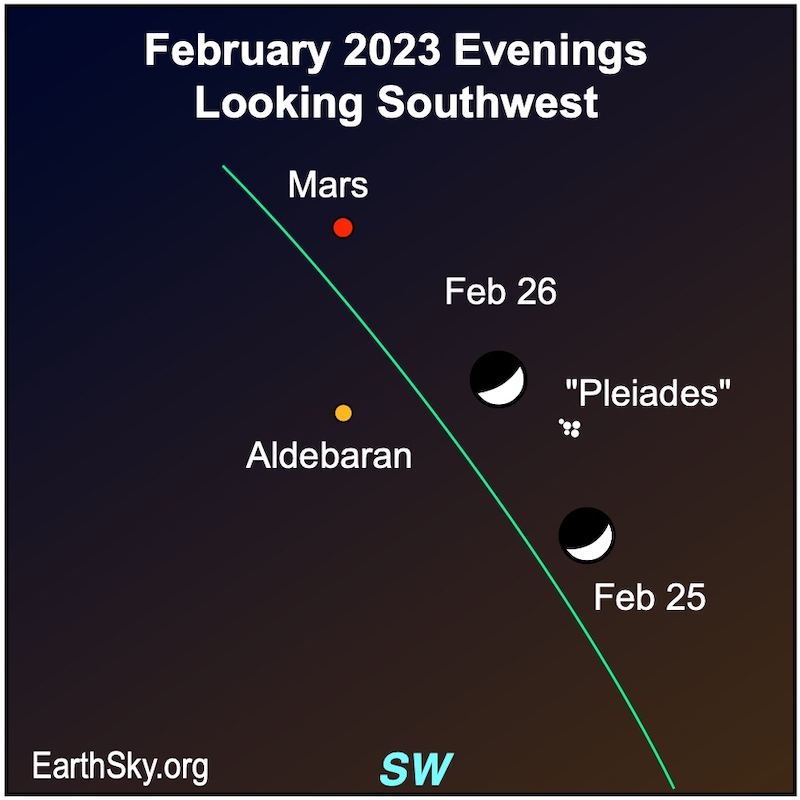
Moon near Pleiades, Aldebaran and Mars
For everyone around the globe, the waxing crescent moon is near the glittering Pleiades star cluster on the nights of February 25 and 26. The Pleiades, shaped like a tiny dipper, are also called the Seven Sisters or Messier 45 (M45). They’re a true family of stars, born together and still moving together as a family. And they are also fabulous in binoculars!
Also nearby, you’ll find a bright red star. It’s Aldebaran, the fiery eye of Taurus the Bull. Aldebaran is one of our sky’s brightest stars. It’s part of a V-shaped group of stars – the Hyades – that forms the Bull’s face.
By the way, although Aldebaran appears among them, it is not actually a member of the Hyades star cluster. The fact is, it’s actually much closer to us in space than the other stars of the Hyades cluster.
Now look again. There’s another bright red light nearby. It’s the red planet, Mars – which was at its brightest during its opposition in December – and which is now fading day by day, as we race away from it in our smaller, faster orbit around the sun. But Mars is still plenty bright! It’s still slightly brighter than Aldebaran. You’ll enjoy picking it out among the stars on these evenings.
The moon, Mars and Taurus will descend below the western horizon shortly after midnight. So catch them in the evening before they slip away for the day.
Since the view of the stars, moon and planets varies by your position on the globe, we suggest you try Stellarium for a precise star chart for your location.
Last chance to get a moon phase calendar! Only a few left.
Bottom line: Watch for the moon near the Pleiades – a beautiful star cluster – on the evenings of February 25 and 26. Also nearby you’ll find Mars and the bright star Aldebaran.
For more great observing events in the coming weeks, visit EarthSky’s night sky guide
The post Moon near Pleiades, and more, February 25 and 26 first appeared on EarthSky.
from EarthSky https://ift.tt/5gt1IRq

Moon near Pleiades, Aldebaran and Mars
For everyone around the globe, the waxing crescent moon is near the glittering Pleiades star cluster on the nights of February 25 and 26. The Pleiades, shaped like a tiny dipper, are also called the Seven Sisters or Messier 45 (M45). They’re a true family of stars, born together and still moving together as a family. And they are also fabulous in binoculars!
Also nearby, you’ll find a bright red star. It’s Aldebaran, the fiery eye of Taurus the Bull. Aldebaran is one of our sky’s brightest stars. It’s part of a V-shaped group of stars – the Hyades – that forms the Bull’s face.
By the way, although Aldebaran appears among them, it is not actually a member of the Hyades star cluster. The fact is, it’s actually much closer to us in space than the other stars of the Hyades cluster.
Now look again. There’s another bright red light nearby. It’s the red planet, Mars – which was at its brightest during its opposition in December – and which is now fading day by day, as we race away from it in our smaller, faster orbit around the sun. But Mars is still plenty bright! It’s still slightly brighter than Aldebaran. You’ll enjoy picking it out among the stars on these evenings.
The moon, Mars and Taurus will descend below the western horizon shortly after midnight. So catch them in the evening before they slip away for the day.
Since the view of the stars, moon and planets varies by your position on the globe, we suggest you try Stellarium for a precise star chart for your location.
Last chance to get a moon phase calendar! Only a few left.
Bottom line: Watch for the moon near the Pleiades – a beautiful star cluster – on the evenings of February 25 and 26. Also nearby you’ll find Mars and the bright star Aldebaran.
For more great observing events in the coming weeks, visit EarthSky’s night sky guide
The post Moon near Pleiades, and more, February 25 and 26 first appeared on EarthSky.
from EarthSky https://ift.tt/5gt1IRq

Aucun commentaire:
Enregistrer un commentaire